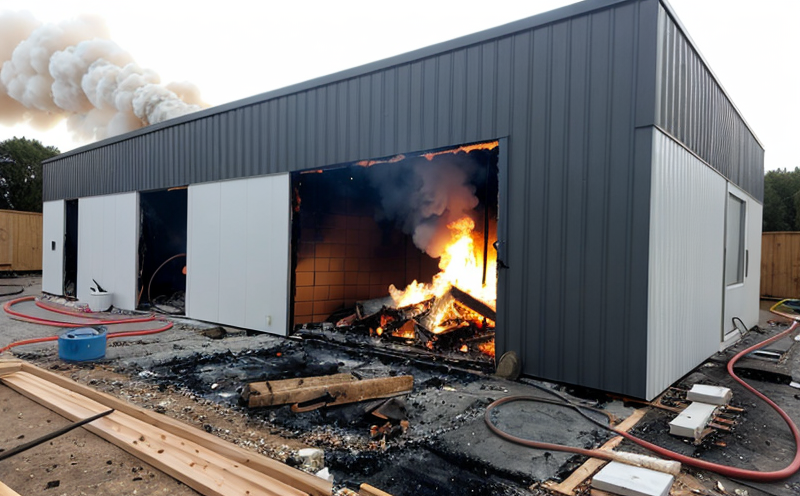BS 476-6 Fire Propagation of Insulation Materials
The BS 476 suite of standards has been a cornerstone in fire safety testing for over half a century. The specific standard, BS 476-6:1987, focuses on the resistance to flame spread and smoke production characteristics of materials used as insulation or cladding. This service is crucial for ensuring that building products meet stringent fire safety requirements.
The test involves placing a specimen in a specially designed furnace where it is exposed to a controlled flame source under defined conditions. The performance of the material is then assessed based on its resistance to ignition, the rate at which flames spread across the surface, and the amount of smoke produced during combustion. This method provides critical data for assessing the fire safety properties of insulation materials.
The testing procedure is not without complexity. Specimens must be prepared meticulously according to standard guidelines. Factors such as thickness, shape, and orientation can affect test results, highlighting the importance of precise sample preparation. The furnace temperature and time duration are also critical parameters that need to be strictly controlled to ensure accurate and reproducible results.
The BS 476-6 test is often used in conjunction with other fire tests from the suite, such as BS 476-2 for structural components or BS 476-13 for external building cladding. These complementary tests provide a comprehensive picture of the fire performance of materials and assemblies.
The results of the BS 476-6 test are typically reported in terms of flame spread index (FSI) and smoke production class (SPC). The FSI is a numerical value that indicates how quickly flames spread across the surface of the material, while SPC provides information about the amount of smoke produced. Both metrics are used to classify materials into categories ranging from A1 to D, with lower numbers indicating better performance.
In real-world applications, this test ensures that insulation and cladding materials used in buildings comply with fire safety regulations. For instance, specifying materials with a low FSI and SPC is essential for reducing the risk of rapid fire spread and minimizing smoke production during a fire. This not only enhances occupant safety but also helps to meet stringent building codes and standards.
The process of obtaining BS 476-6 certification involves several key steps: initial consultation with our technical experts, specimen preparation guidance, furnace setup, test execution, data analysis, and report generation. Our team of experienced professionals ensures that every step is carried out to the highest standards, providing clients with reliable and accurate results.
Quality and Reliability Assurance
- Strict adherence to ISO 9001:2015 quality management system ensuring consistency in test execution.
- Regular calibration of equipment against NIST traceable standards to maintain precision.
- Ongoing staff training and certification by industry experts to ensure competence.
- Comprehensive documentation and audit trails for all testing activities.
Eurolab Advantages
At Eurolab, we pride ourselves on delivering exceptional fire safety testing services. Our state-of-the-art facilities provide the most accurate and reliable results. With a team of highly skilled professionals, we ensure that each test is conducted with precision and care.
- Expertise: Our staff has extensive experience in conducting BS 476-6 tests and related fire safety assessments.
- Technology: We utilize advanced furnaces and measurement instruments to ensure accurate data collection.
- Compliance: All our procedures are meticulously aligned with international standards, ensuring compliance with regulatory requirements.
- Confidentiality: Client confidentiality is paramount, and we maintain the strictest levels of security for all test data.
Quality and Reliability Assurance
In addition to our technical expertise and cutting-edge equipment, Eurolab ensures quality and reliability through stringent internal controls. Our quality management system is certified to ISO 9001:2015, which guarantees that every aspect of the testing process—from sample preparation to final report generation—meets the highest standards.
- Regular equipment calibration against NIST traceable standards ensures accuracy and consistency in measurements.
- Ongoing staff training and certification by industry experts ensure competence and up-to-date knowledge.
- Comprehensive documentation of all testing activities, including audit trails, supports transparency and accountability.
Customer Impact and Satisfaction
The success of our fire safety testing services is reflected in the satisfaction of our clients. By providing accurate, reliable, and compliant test results, we help ensure that insulation materials meet stringent fire safety requirements. This not only enhances occupant safety but also supports compliance with building codes and regulations.
Our commitment to quality and reliability has earned us a reputation for excellence in the industry. Clients appreciate our expert guidance throughout the testing process, from initial consultation to final report delivery. We pride ourselves on delivering results that meet or exceed client expectations, ensuring peace of mind for those responsible for fire safety.





